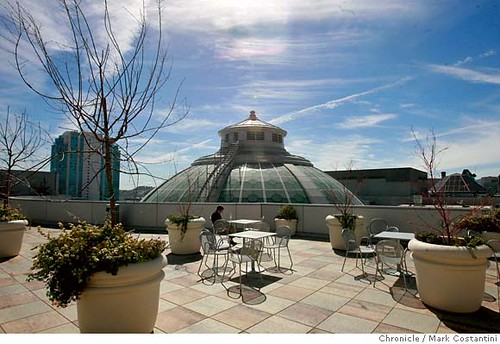Private spaces as public spaces: legal rights of property owners vs. legal rights of citizens to use the space

Privately Owned Public Spaces logo/indicator used in New York City to denote privately owned spaces that are open to the public.
Years ago on the urbanists e-list we were discussing issues arising from the private management of a public street, such as Ellsworth Avenue in Silver Spring, Maryland--the property manager, Peterson Companies, told people they were not allowed to take photographs, and a lawyer on the list, Chris Brewster, pointed to an older Supreme Court case, Marsh v. Alabama (1946), and wrote:
I do not know if it has been overturned or substantially distinguished by other more recent cases, but it seems to be directly on point to Silver Spring and Ave Maria issues, with only the contemporary parallel of company towns of the 30's and 40's to HOA/Property Management Towns of the 80's, 90's (or "Catholic Church towns" of the 00's??) - very easy parallel for me, anyway.
Ultimately, the very fuzzy rule of this case is: "The more an owner, for his advantage, opens up his property for use by the public in general, the more do his rights become circumscribed by the statutory and constitutional rights of those who use it."
This comes up because of the Occupy Wall Street movement's use of Zuccotti Park in Manhattan, which is a privately owned "public" park where public access was provided to the space in return for zoning relief and/or benefits by the original developer of the building.
In New York City and San Francisco especially, this has been a common practice, because the amount of relief awarded could be considerable (e.g., in NYC, 10 s.f. of additional developable space for each s.f. of "public access space" provided).
In NYC, Jerold Kayden did a study (and book, Privately Owned Public Space: The New York City Experience) evaluating the impact of the law, the quality, level of access, and the use of the spaces.
-- Privately Owned Public Spaces webpage, New York City Department of City Planning
He has an op-ed in the New York Times about this, "Meet Me at the Plaza," because as a result of the Occupy Wall Street protest, developers are asking for more specific rules governing their management and the use of the space, including restricting access with regard to protest.
From the article:
Since 1961, the City Planning Commission has used zoning laws to give developers the right to build over 20 million square feet of extra residential and office floor space in return for providing more than 500 public plazas, arcades and indoor spaces. On paper, it reads like a great deal that, at little cost to the city, has given it enough additional public space to cover 10 percent of Central Park.
But the comparison between privately owned public spaces and Central Park stops there. Too many of them — roughly 40 percent, according to a 2000 study I conducted with the Department of City Planning and the Municipal Art Society and that still holds today — were and are practically useless, with austere designs, no amenities and little or no direct sunlight. Roughly half of the buildings surveyed had spaces that were illegally closed or otherwise privatized. ...
Nevertheless, the events at Zuccotti Park highlight the continued inadequacy of the laws regarding privately owned public spaces. Other than the requirement that this space remain open 24 hours a day, the owners were left to promulgate their own rules; the only limit is that they be “reasonable.” ...
Given the drama downtown, it’s unlikely that this vagueness will last much longer. In fact, the Real Estate Board of New York is reportedly preparing to ask the city to endorse universally applicable rules prohibiting future Occupy Wall Street-style use of public space, along with the automatic right to close all spaces at night.
Such proposals raise important questions. Should owners be allowed to prohibit use by organized large groups, whether for political rallies or spontaneous gatherings? Are passive activities like quiet conversation or lunchtime eating to become the only approved conduct? Should all owners have the right to close their spaces at night?

Room rates at the new Intercontinental Hotel in San Francisco start at $259. Two spacious terraces, however, are free to anyone who walks in from the street. They're perched off the fourth and sixth floors, and each is drenched in sun during the afternoon. But they aren't as stylish as the hotel bar, where vintage glass is on display and a hamburger costs $16. As of last week, the terraces' decor consisted of stone pavers, sickly bamboo in planters, and a grand total of 19 chairs. San Francisco Chronicle photo by Mark Constantini.
Note that, following in the footsteps of Jerold Kayden, San Francisco's public space advocacy group Re:bar did a similar survey there, which John King of the San Francisco Chronicle wrote about in "Little-known open spaces enhance downtown S.F."
From the article:
Corporate plazas have been part of the downtown landscape since 1959, when the Crown Zellerbach Building at Bush and Market streets opened with a sunken plaza that opened up views. Time magazine praised it as spectacular. Soon after, the planning code was loosened to allow developers to build larger towers if they cleared away space on the ground.
The result was corporate plateaus that often were no more than widened sidewalks. So in 1985, officials changed such spaces from a perk to a requirement. Builders had to provide 1 square foot of public space per 50 square feet of commercial space. Additional formulas spelled out the required seating and made it obligatory to have an informational plaque at street level stating the public hours. Buildings also had to "provide toilet spaces open to the public." ... But once the spaces exist, they're controlled by building owners who may not want the public to put them to use. ...
We've achieved a variety of open spaces. What is deficient is a rigorous enforcement of the guidelines that are in place," said Eva Liebermann, a retired city planner who worked on the 1985 plan. "These are required public spaces, in return for the privilege of building in downtown San Francisco."
At the Intercontinental, planners notified the developer this month that the public seating was deficient. Additional tables and chairs are now on order.
-- Re:bar webpage on Commonspace
-- San Francisco Planning and Urban Research Association report on privately owned public open spaces
-- map of privately owned public open spaces, Downtown San Francisco, San Francisco Chronicle
Labels: civic engagement, freedom of assembly/First Amendment, Growth Machine, law and the legal process, participatory democracy and empowered participation, urban design/placemaking



0 Comments:
Post a Comment
<< Home